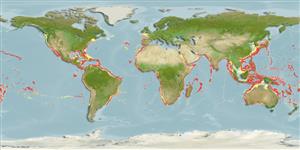Common names from other countries
Environment: milieu / climate zone / depth range / distribution range
Ecologia
marinhas bentopelágico; oceanódromo (Ref. 51243); intervalo de profundidade 80 - 800 m (Ref. 2683), usually 300 - 400 m (Ref. 5217). Subtropical; 50°N - 36°S, 180°W - 180°E
Tropical and warm temperate waters of all oceans, but absent from eastern Pacific except at Sala y Gomez Ridge.
Length at first maturity / Tamanho / Peso / Idade
Maturity: Lm 47.4 range ? - ? cm
Max length : 100.0 cm SL macho/indeterminado; (Ref. 6181); common length : 40.0 cm SL macho/indeterminado; (Ref. 3403)
Espinhos dorsais (total) : 18 - 20; Raios dorsais moles (total) : 17 - 20; Espinhos anais: 2 - 3; Raios anais moles: 15 - 17. Body moderately elongate. Mouth with fang-like teeth. Spinescent gill rakers on the first arch with 1 - 3 cusps and many small spines; the angular raker long and triple-rooted. Body entirely scaled at over 20 - 25 cm SL. Pyloric caeca 7 or 8. Color is grayish to copper brown; fins blackish at over 40 cm SL, yellowish with black tips in smaller specimens (the first dorsal fin with a black blotch on two anteriormost membranes); the buccal and branchial cavities are black. Pelvic fin reduced to one spine that becomes entirely absent in specimens more than 40 cm SL.
Found at continental slopes, around oceanic islands and submarine rises (Ref. 6181). Meso-benthopelagic (Ref. 58302). Migrate to midwater at night (Ref. 6181). Feed on fish, cephalopods and crustaceans (Ref. 6181). Eggs and larvae are pelagic (Ref. 6766).
Probably spawns throughout the year in warmer seas.
Nakamura, I. and N.V. Parin, 1993. FAO Species Catalogue. Vol. 15. Snake mackerels and cutlassfishes of the world (families Gempylidae and Trichiuridae). An annotated and illustrated catalogue of the snake mackerels, snoeks, escolars, gemfishes, sackfishes, domine, oilfish, cutlassfishes,. scabbardfishes, hairtails, and frostfishes known to date. FAO Fish. Synop. 125(15):136 p. (Ref. 6181)
Categoria na Lista Vermelha da IUCN (Ref. 130435)
CITES (Ref. 128078)
Not Evaluated
Ameaça para o homem
Reports of ciguatera poisoning (Ref. 31637)
Utilização humana
Pescarias: pescarias de subsistência; peixe desportivo: sim; isco: usually
Ferramentas
Relatórios especiais
Descarregue XML
Fontes da internet
Estimates based on models
Preferred temperature (Ref.
115969): 8.6 - 16.5, mean 11.1 (based on 329 cells).
Phylogenetic diversity index (Ref.
82804): PD
50 = 1.0000 [Uniqueness, from 0.5 = low to 2.0 = high].
Bayesian length-weight: a=0.00363 (0.00224 - 0.00588), b=3.06 (2.92 - 3.20), in cm Total Length, based on LWR estimates for this species & (Sub)family-body (Ref.
93245).
Nível Trófico (Ref.
69278): 4.2 ±0.57 se; based on food items.
Resiliência (Ref.
120179): Médio, tempo mínimo de duplicação da população 1,4 - 4,4 anos (K=0.17-0.18; tm=4).
Fishing Vulnerability (Ref.
59153): High vulnerability (58 of 100).
Climate Vulnerability (Ref.
125649): Moderate vulnerability (39 of 100).
